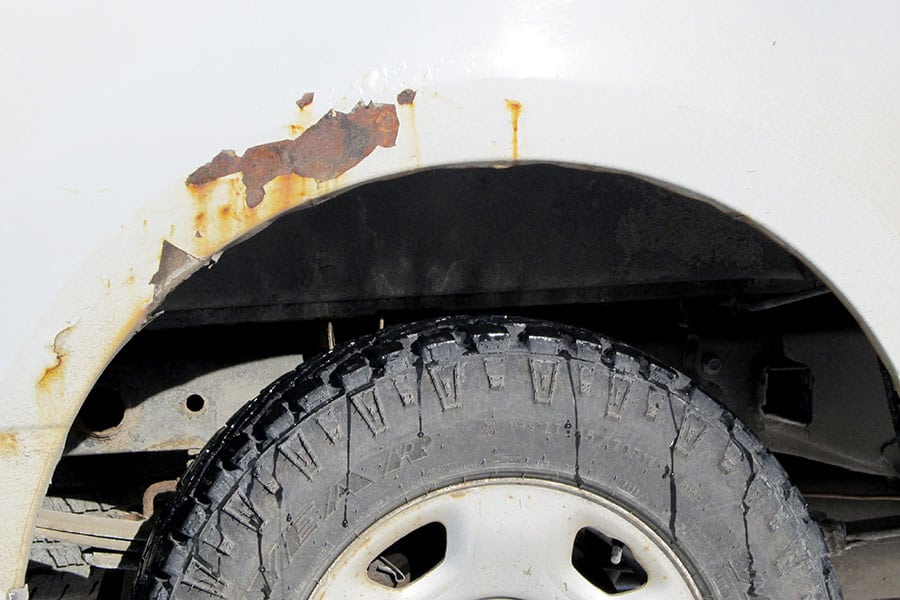
In my opinion, Sprinter vans are a great vehicle. Stylish and tough, they are the perfect combination of a box truck and classic van. However, one thing Sprinter owners complain about is rust, which makes them a somewhat high maintenance van to own.
Why do Sprinter vans rust? Sprinter vans are out on the road a lot and can be a target of rusting anywhere there is a lack of moisture-proof finishing. Living in a high humidity climate can also accelerate the spread of rust if not taken care of promptly.
Sprinter van uses include commercial hauling and personal use in the ever-growing trend of the #VANLIFE movement.
In this post, I will try and unveil the mystery of why Sprinter vans are so susceptible to rust, and what you can do about it. We’ll talk about how to get ahead of the problem and act at the first sign of rust setting in. We’ll also talk about how to use preventative measures to stop it in its tracks. You can conquer rust!
Why Do Sprinter Vans Rust So Bad?
Buyers beware; owners take care. If you are contemplating buying a Sprinter van, one major thing to be on the lookout for is large or progressed rust spots. Buying a Sprinter with a laundry list of issues will cost you big time in the future. If you already have a Sprinter, you have to stay on your toes to keep it going for a long time.
Rust is iron oxide, a chemical reaction that is caused by metal mixing with oxygen and moisture. Corrosion of the metal body of a Sprinter is common, often found inside, outside, on the floor, roof and doors.
Once rust starts to set in, it is like an infection that will not stop spreading until you address the problem. We have seen it on plenty of aged pieces of metal, but why is it happening to relatively new metal?
When vans come from the factory, they have seams, gaps and metal-to-metal interior framework. The metal wall panels have v-shaped pouches that easily trap water when it gets inside. Overall, Sprinters don’t have any finishing touches to help absorb condensation and protect the metal. Any moisture in a Sprinter sits on metal. And what happens to moistened metal? Rust.
The most popular use for Sprinter vans are as delivery vehicles that companies keep fleets of for business purposes; they have to be versatile enough to cater to everyone. The interior of a Sprinter is entirely customizable due to its metal arches, pockets and optional spots for more windows. Also, this unfinished state means an exposed metal area that is prone to rust.
Does Weather Impact Rust On A Sprinter Van?
Think about the weather in your area. Is it humid, rainy, or snowy? Snow is dangerous in a few ways, and we’re about to find out what it means in the case of rust on your van. During freezing temperatures, roads can become slick and icy.
Let’s face it; Sprinter vans are on the road a lot and not very often coddled in a warm, dry garage somewhere. They are outside working and exposed to the environment, which is not always kind out there.
Winter – It’s Not The Weather So Much As The Road Salt
When roads are slippery, city and state agencies send out fleets of trucks to coat the roads with anti-skid material or a spray of brine to help prevent accidents. We initially sprinkled rock salt on the roads to prevent icing. Now one of the things they rely on is a mixture of salt and water known as brine. Brine is cheaper, helping to keep the city or state agencies within their budget by reducing costs.
Brine is better in the sense that it coats the roads and cracks in the blacktop. That also means that it covers your vehicle and the cracks in it. Brine is known for destroying undercarriages and paint jobs. It’s bad news for everything but the road. Brine, or road salt, is extremely corrosive and a significant cause of rust.
By removing the salty spray from your van as quickly as possible, you can help stop rust and other costly vehicle headaches. Washing your vehicle more often when covered with brine is an excellent rust preventative measure.
Summer – How Heat And Moisture Affect A Sprinter
We now know that salt is one of rust’s best friends, right? To fight rust, you must think like rust. If you deny it what it feeds off of, you can stop it in its tracks.
Nature is not always kind to metal. You may love living in an area like the beach, but chances are your vehicles might not like it as much as you do. Salt plus water equals a poor environment for the paint on your Sprinter.
The ocean is full of salt, and it travels through the air. When it lands on your vehicle, it can cause significant damage to the finish and the paint, in addition to any exposed metal in the undercarriage.
Sprinter vans don’t like the extreme moisture in the air at the beach because they are prone to forming condensation inside. Due to the gaps in metal and without moisture-wicking layers like insulation and fabric finishes, moisture tends to hang out longer in a Sprinter than it does in other types of vehicles.
In addition, while the drying sun may help combat moisture, too much exposure to the baking-hot sun can be detrimental to the paint and weaken the defenses a Sprinter has against rust.
Store Your Sprinter Out Of The Sun And Moist Air
Storing vehicles in a garage can help prevent the hot sun from baking salt into your paint and can help prevent the color from fading. Washing the exterior at least once a week removes nature’s accumulated grime from your vehicle.
You can make the job easier with this power washer from Simpson. It has a 25-foot high-pressure hose, easy to hold spray gun, detergent tank, and the handle folds down, making storage a breeze. Or, if you want to use a bucket, this wash kit contains everything you need.
When you finish this post, here are a few other posts of interest.
• How Long Do Sprinter Vans Last?
• Can A Sprinter Van Fit In A Garage?
• The 8 Best Vans You Can Camp In
• How High Is A Mercedes-Benz Sprinter Van? A Complete Guide
How To Treat The Rust On A Sprinter Van
Can you fix it? Yes, you can! We will go over the process step-by-step and run through a checklist of tools and supplies that you will need.
Read through thoroughly before you make a purchase. It also can’t hurt to check out a few tutorial videos online. The entire repair process can take a few hours or longer depending on the amount of rust.
The Prep
| Personal SAFETY | Products You Need | Proper Tools | Working Location |
|---|---|---|---|
| Protective Eye-Wear | Rust Removing Spray or Gel | Clean Dry Rags | Clean Work Place |
| Dust Mask or Respirator | Wax and Grease Remover | Masking Tape | Well Ventilated Area |
| Gloves | Applicators | Electric Drill with Wire Brush | Well-Lit Work Space |
| Long Sleeve Shirt | Primer | Sanding Block | Out of the Wind |
| Long Pants | Paint | Sandpaper and Fine Grit Disks | Out of Direct Sunlight |
For stripping rust and paint off, this disc from Scotch-Brite will work well. It fits in a standard drill that you probably already own, contours to the vehicle’s surface, and makes fast work of removing rust.
If you need sanding discs, here is a 300 piece set that will work great for sanding down body filler or smoothing up rough places. The kit has a 1×1/4 inch metal shaft so that you can use it in your drill.
When it comes time to repaint, don’t forget to have your surface clean of oil, wax and grease, and other contaminants. This prep spray will help you get a quality paint job.
Step-by-Step Guide
- Gear up
- Start with a clean and dry surface
- Tape off the area you are working on
- Follow the directions on the rust remover bottle carefully
- Sand the area
- Use wax and grease remover
- Allow to dry
- Sand and dust
- Prime
- Paint
For larger areas of rust, you most likely will need to use body filler in between steps 8 and 9. Especially if there are pits or holes in the metal.
Get Some Professional Help
If you are not feeling enthusiastic or confident about tackling this project, there are plenty of professional auto body shops out there that would be happy to help you.
A word from the wise. If your budget is limited, try asking around for a recommendation of a reputable “backyard mechanic.” You don’t need a storefront and big fancy garage to turn out flawless bodywork. And often, those living the #VANLIFE can help hook you up.
Plenty of pros are running their shops out of their garages at home, doing bodywork as either a part-time side job or cranking out cars all day long.
Preventing Rust On A Sprinter
Let’s be proactive about rust; save yourself from future headaches.
Utilizing the garage – Maybe it is time to clear a space in the garage for your van to keep it safer from the elements outdoors.
Moisture prevention – Moisture absorbing products can be your van’s best friend! Try some moisture-absorbing packs or a portable dehumidifier.
Watch it – If you begin to see your paint bubble up or catch a glimpse of a small rust patch, the best thing you can do is to take care of it ASAP. Do a rust search once a month, under, over, inside and out. Only you can prevent rust from spreading on your Sprinter.
Reapplying clear coat – Treat your van to a refreshing new coat of clear coat at your local auto paint shop to prevent rust.
It’s true; things just aren’t made like they were in the old days. Vehicles are no exception. Sure, the clear coats applied over your van’s paint are not only great for a shiny reflective looking finish but also helpful in serving as a protectant from rust.






